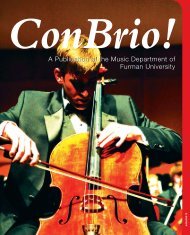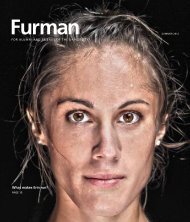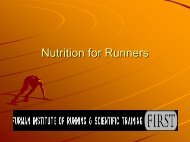Download - Furman University
Download - Furman University
Download - Furman University
- No tags were found...
You also want an ePaper? Increase the reach of your titles
YUMPU automatically turns print PDFs into web optimized ePapers that Google loves.
<strong>Furman</strong> ALUMNI NEWSSEEWHAT’SON EDGEWHEN YOU SEE the EDGEsymbol with any story in thisissue, you’ll know that digitaladditions and enhancementsrelated to the article (videoclips, slide shows, etc.) areavailable at edge.furman.edu.The EDGE site is meant toenhance and complement theprint magazine and is especiallycompatible with smart phonesand tablets. And in additionto <strong>Furman</strong> magazine, EDGEcontains an ever changingcollection of stories and photofeatures about university life.EDGE also includes alink to <strong>Furman</strong> magazinein its traditional PDF form(furman.edu/fumag). That’swhere Class Notes is availableand where you can seearchived issues, submit newsfor class notes, or completea quick survey.Those who would preferto receive the magazine inelectronic form only shouldemail jim.stewart@furman.edu.William Joseph Cantrell, M.A. ’62,December 15, Spartanburg, S.C. He wasretired from Spartanburg School District 7,having taught and served as an administratorin a number of elementary schools. Hewas also minister of music and organist atFirst Baptist Church of Boiling Springs, S.C.,for many years. He was a member of theNational and the South Carolina educationassociations, School Masters, the SpartanburgHistorical Society, Woodmen of theWorld, the Spartanburg Wellness Center,and the 50 Year Club of Wofford College.He was an accomplished calligrapher,painter and pianist.Mary Lee Cheek ’62, December 21,Taylors, S.C. She started her career as a thirdgrade teacher and later became director ofweekday preschool ministries at Taylors FirstBaptist Church, a position she held for 28years.Oneida Watts Sibley ’62, February 27,Carmel, Ind. Neida was active in volunteerwork, especially in the field of music, andwas involved with symphony orchestraassociations in several cities. She played aleading role in the founding of the SchadtInternational String Competition for theAllentown (Pa.) Symphony Orchestra.Jack Nelson Bethea ’64, February 25,Marion, S.C. Jack was employed withCarolina Power and Light/Progress Energy-Duke, from which he retired as line servicesupervisor after 33 years. A past president ofthe Swamp Fox Booster Club, he served inthe National Guard and was a Little Leaguecoach and member of the Lions Club.Luther C. Elrod III ’64, March 10, RockHill, S.C. Luke earned a law degree from the<strong>University</strong> of South Carolina and began hislegal career as a captain in the U.S. ArmyJudge Advocate General Corps in Germany.After completing military service he joinedthe John Bolt Culbertson firm in Greenville,then moved to Rock Hill in 1979 to starthis own practice. He was a member of theSouth Carolina Bar Association, the InjuredWorkers’ Advocates and the South CarolinaTrial Lawyers Association, and was activewith the YMCA of Rock Hill.Catherine Patricia Denny Miller’64, December 21, Lexington, S.C. Patriciaworked with Miller Auctions & Land andwas co-pastor of Living Waters ChristianFellowship.Barry Martin Shaw ’64, January 28,Natick, Mass. After earning a doctoratein physics from the <strong>University</strong> of Tennessee,he worked as chief executive officerof Engineered Yarns. In 1989 he movedinto academics and taught physics andmathematics at the Naval War Collegein Newport, R.I., until he retired.Helen Hester Porter ’65, February 3,Greenville. An avid reader, Helen wasa member of Chapter 76 Book Club.She was also a charter member of theGreenville Legal Auxiliary and was instrumentalin starting the PTSO at TravelersRest High School.Bruce R. Byers ’70, January 19, WinterPark, Fla. He was a coach in Augusta, Ga.,prior to serving a tour of duty in the U.S.Army. He left the military in 1987 and thentaught and coached at Lake Bentley HighSchool for 25 years.Thad W. Herbert, Sr., MBA ’74, March1, Greenwood, S.C. He worked with C&SNational Bank and SCN of Greenville andlater was president of Carolina NationalBank in Easley, S.C. He was active in churchwork and treasurer of the South CarolinaConference of the United MethodistChurch. Thad was a Paul Harris Fellow,a past president of the Easley Rotary Cluband a former chair of the Library Board.He was the first chair of the Pickens CountyUnited Way as well as the Easley PlanningCommission. A U.S. Army veteran of WorldWar II, he served in the South Pacific.Frank Camden Owens III ’75, February15, Greenville. Cam’s professional lifeincluded work as a real estate agent, sportsagent and financial advisor.Luther Wesley White IV ’77, January25, Richmond, Va. Luke was a pioneerin the design and installation of solarsystems for home heating. He expandedhis business to include the construction ofswimming pools for residential use and wasthe Richmond-area franchisee of Foxx PoolCompany for 25 years, operating under thecorporate name of Richmond Pool and PatioCompany.Christopher Barnes Bennett ’79,January 4, McKinney, Texas. After earninga master’s degree in geophysics from the<strong>University</strong> of Texas, he worked as a geophysicistwith Arco Oil and Gas. He wasalso an environmental geologist. At thetime of his death he was a managingconsultant for MasterCard Advisors.Victor William Wolf, Jr. ’79, March 26,Blacksburg, Va. He earned a Master ofDivinity degree from Covenant TheologicalSeminary and became senior pastor ofValley Reformed Presbyterian Church inRoanoke, Va. He later earned a master’sdegree in counseling and in 1996 joinedGrace Covenant Presbyterian Church inBlacksburg as associate pastor and elder.He was a licensed practicing counselorand a therapist for sex offenders.Robert Martin Porterfield ’80,December 14, Rincon, Ga. Robby wasassociated with Bradwell Institute and spent30 years as a teacher, mentor, administratorand coach. He was active in prison ministryand with the Gideons, and was a memberof the Rotary of Effingham Sunrise.Stephen E. Matton II ’85, December 15,Atlanta. He was a professional golfer andteaching professional for many years atthe PGA Tour Superstores. He also ownedYoforia Frozen Yogurt in Sandy Springs,Ga., and was active in many charitableorganizations.Daniel DeGeeter ’89, January 12,Sussex, N.J. He was a sales counselorat George Washington Memorial Parkin Paramus, N.J., for 15 years and wasactive in the local Rotary Club.Lillian Etolia Smith Eubanks, M.A. ’89,January 26, Greenville. Etolia was retiredfrom the Greenville County School System.Jeremy Thomas Letton ’93, January 27,Columbia, S.C. He owned and operatedthe Garden Bistro restaurant.BIKING AND BUILDING COMMUNITY, FROM CHICAGO TO AFRICA“PARTS OF WINDHOEK, Namibia’s capital city, and bicycles donated from abroad and distributes themthe South Side of Chicago are actually eerily similar,” to low-income people via community bike shopssays Dustin Gourdin ’10, a Ph.D. student in the <strong>University</strong>of Chicago’s sociology department. “You see a lot Despite the country’s strong national economy,housed in converted shipping containers.of the same issues, in terms of transportation challenges roughly half of the population lives in poverty.and youth opportunities. Hopefully we can figure out “You see a lot of growth that benefits small pocketsways to make things better in both places.”of the population that doesn’t necessarily translateSince 2009 Gourdin, 25, has made three research into opportunities for people at ground level, especiallyurban youth,” he says. BEN’s shops teachtrips to Namibia, a nation of 2.1 million people justnorthwest of South Africa. He’s been studying the mechanic skills to these young people and helpBicycling Empowerment Network (BEN) Namibia, them develop bike-powered businesses.a nonprofit that provides disadvantaged local people One of BEN’s most successful programs provideswith efficient transportation and job opportunities, bicycles to the mostly female healthcare workers whoas well as other non-governmental organizations. tend to Namibia’s large HIV-positive population. LargelySince gaining independence in 1990, the country, desert, the country has the world’s second-lowest populationdensity after Mongolia. Bikes make it much easierwith an economy based on mining, agriculture andtourism, has become an upper-middle-income nation. for the caregivers to serve their clients in remote villages.Gourdin is exploring the connection between U.S.-BEN accepts shipments of cycles from sister organizationsall over the world, including Working Bikessponsored empowerment programs and Namibia’srecent macro-level growth. Meanwhile, back in Chicago, Cooperative in the Little Village area of Chicago, wherehe’s involved with several groups that encourage cycling Gourdin currently volunteers, sorting spare parts andin low-income neighborhoods and communities of color. loading shipping containers. “It’s been really interestingBorn in South Carolina, Gourdin first got passionate to watch the process play out in Chicago and then seeabout bikes as a freshman at <strong>Furman</strong>. After the brake how it turns into results in Namibia,” he says. “I gotcables on his Walmart beater snapped, he Googled to see firsthand the people who get employed by these“brakeless bicycle” for repair instructions and stumbled projects and programs and how it changes their lives.”upon a YouTube video called “Mash SF” of guys riding Gourdin has witnessed the power of bicycles tofixed-gears around San Francisco.transform lives through his work at Blackstone Bicycle“It had an edge to it, like a skateboard video,” he Works, a community bike shop and youth educationprogram on Chicago’s South Side. “It gives a lotrecalls. “I adopted that philosophy: ride a bike the wayyou want to ride.” He converted his mom’s old road of neighborhood kids an opportunity to learn aboutbike into a single-speed and eventually saved enough bicycles and transportation,” he says. “They gain somemoney for an IRO Cycle fixie. He and his buddies formed independence and autonomy from their ability to travela bicycle crew called the Rolling Riot, cruising the streets on their own, and it gives them something positive toof Greenville and its Swamp Rabbit Trail.do after school.”A rap fan, Gourdin became aware of the AfricanHe also rides with Red Bike and Green, a group“blood diamond” phenomenon, where sales of diamondsmined in war zones bankroll bloodshed, through to health, wealth and environmental sustainability.that promotes cycling to African Americans as a paththe track “Diamonds Are Forever (Diamonds From Sierra “They’re a really neat organization,” he says. “ForLeone)” by Kanye West, as well as the movies “Blood me, coming from South Carolina, seeing a contingentDiamond” and “The Last King of Scotland.” He soon of black urban cyclists was something new.”joined the student group Africa Rising, which promoted Gourdin sees many parallels between the economic,social justice on the continent, and then got the idea health, education and transportation challenges facingto study abroad in Namibia.low-income folks in the Namibian capital and their“I was looking for a way to bind my passions for counterparts on the South Side of Chicago. “Windhoekbiking and social justice,” Gourdin says. He focused his has a lot of infrastructure issues,” he says. “There areresearch on BEN Namibia, which receives shipments of enough roads but there’s just not a great public transitDustin Gourdin was on the football and track and field teamsat <strong>Furman</strong>. He says, “<strong>Furman</strong>’s really one of the few schools thatallow student-athletes to be exactly that: students and athletes.”system and there are virtually no bicycle lanes — that’sbeen something that the people at BEN have beenpushing for.“It’s similar on the South Side,” he says. “We coulduse more consistent public transit here, and peoplecould really benefit from using a bike as a form oftransportation. You need to take a balanced approachto community development, including things like afterschoolprogramming and access to healthcare, whichshould be a basic human right. But providing goodtransportation options is really in that holy grail ofwhat needs to be done to build a community.”Gourdin recently received grant money from the<strong>University</strong> of Chicago’s Council on Advanced Studiesand hopes to return to Namibia this summer to continuehis research. “Every time I go I think it’s going to be mylast,” he says. “But you end up building a relationshipwith people and organizations, and you start to geta vested interest in seeing them succeed.”— JOHN GREENFIELDReprinted with permission from the February 19 issueof newcity.com. Photo by John Greenfield.38 FURMAN | SPRING 2013FURMAN | SPRING 2013 39



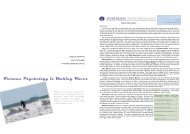
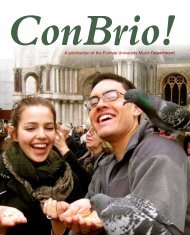
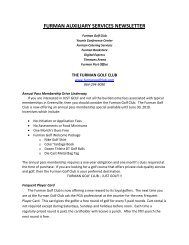
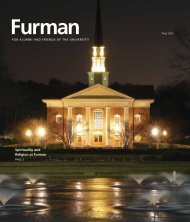
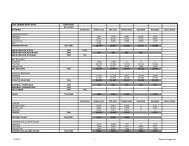
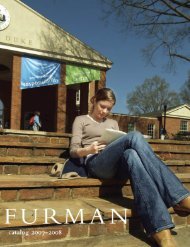
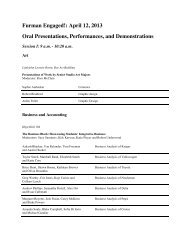

![Guidelines [PDF] - Furman University](https://img.yumpu.com/43814619/1/190x245/guidelines-pdf-furman-university.jpg?quality=85)
